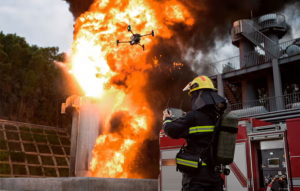 Drones have become invaluable assets within the fire service, with their adoption expected to rise steadily as technology advances. Their role in fire response has evolved beyond aerial surveillance, now encompassing tasks that were once limited to on-the-ground personnel. With capabilities such as thermal imaging, precise water and fire-retardant deployment, and real-time situational awareness, drones are transforming how fire departments address emergencies.
Drones have become invaluable assets within the fire service, with their adoption expected to rise steadily as technology advances. Their role in fire response has evolved beyond aerial surveillance, now encompassing tasks that were once limited to on-the-ground personnel. With capabilities such as thermal imaging, precise water and fire-retardant deployment, and real-time situational awareness, drones are transforming how fire departments address emergencies.
Expanding Roles of Drones in Firefighting
- Aerial Surveillance and Scene Assessment
Equipped with high-definition cameras and thermal sensors, drones can rapidly survey large areas, locate hot spots, and provide a comprehensive view of fire dynamics. This level of visibility is particularly useful for wildfires and complex urban environments, where identifying fire patterns and potential hazards from the air saves time and provides critical insights for deploying resources effectively.
- Targeted Fire Suppression
Fire departments are increasingly leveraging drones for targeted fire suppression. Equipped with payloads that can release water or fire-retardant agents, drones enable precise interventions, especially in high-rise buildings or forested regions that are challenging for conventional firefighting methods. This approach reduces water wastage and ensures fire suppression is directed exactly where it’s needed.
- Search and Rescue Operations
In rescue missions, drones are instrumental in locating missing persons and guiding rescuers. Infrared and thermal sensors on drones help locate individuals through smoke, debris, and darkness, making rescue efforts more efficient and less risky for firefighters. Some drones are even equipped to carry life-saving supplies to isolated areas, providing immediate aid until ground teams can arrive.
- Post-Fire Assessment and Data Collection
After a fire is contained, drones continue to provide value through post-event assessments. They capture high-quality images and data, allowing investigators to analyze fire behavior, determine points of origin, and assess structural damage. This data contributes to strategic improvements, enabling fire departments to refine response techniques and better prepare for future incidents.
Technology Driving Increased Adoption
Advancements in drone technology are directly impacting their expanded use in firefighting. Innovations such as longer battery life, higher payload capacity, and real-time data analytics allow drones to operate for extended periods and handle diverse fire scenarios. Moreover, as 5G and Tactile Internet technology advance, drones will be able to operate with ultra-low latency, enabling more precise and responsive remote control—essential in critical, time-sensitive situations.
Addressing Challenges: Training, Regulations, and Integration
 While the advantages are numerous, integrating drones into fire service workflows presents challenges. Fire departments need specialized training to operate drones effectively, especially given their expanding functionality. Additionally, regulatory frameworks must evolve to support drone use in emergency response settings, ensuring that drone operations do not conflict with manned aircraft and that privacy concerns are respected. Investment in secure, resilient communication networks is also essential to prevent interference or control disruptions during emergency operations.
While the advantages are numerous, integrating drones into fire service workflows presents challenges. Fire departments need specialized training to operate drones effectively, especially given their expanding functionality. Additionally, regulatory frameworks must evolve to support drone use in emergency response settings, ensuring that drone operations do not conflict with manned aircraft and that privacy concerns are respected. Investment in secure, resilient communication networks is also essential to prevent interference or control disruptions during emergency operations.
The Future of Drones in Firefighting
The trajectory for drone use in the fire service is clear: drones are set to become a staple in modern firefighting, supported by ongoing technological advancements and improved accessibility. As departments continue to recognize the multifaceted benefits—enhanced safety for personnel, efficient resource allocation, and expanded operational capabilities—their adoption will keep growing.
Drones are revolutionizing the fire service, with uses that are expanding as fast as the technology itself. They are empowering fire departments to tackle emergencies with greater accuracy, safety, and effectiveness. With proper training, supportive regulations, and continual technological improvements, drones will only become more integral in the fire service, ultimately enhancing public safety and saving lives.























































